Country Analysis: International Trade, Finance, & Investment
VerifiedAdded on 2023/06/15
|15
|4613
|458
Report
AI Summary
This report provides an overview of international trade, finance, and investment, focusing on the financial markets, capital allocation within domestic and international economies, and the challenges faced by a selected country (India) due to industrialization and trade policies. It discusses the background of financial markets, including capital, derivative, commodity, money, and foreign exchange markets, and the key players involved. The report further examines capital allocation within domestic and international markets, highlighting the role of financial institutions and regulatory bodies. Finally, it evaluates the Indian economy, addressing the challenges it faces due to industrialization and trade policies, such as corruption, tax problems, environmental concerns, and infrastructure limitations, and provides recommendations for improvement.
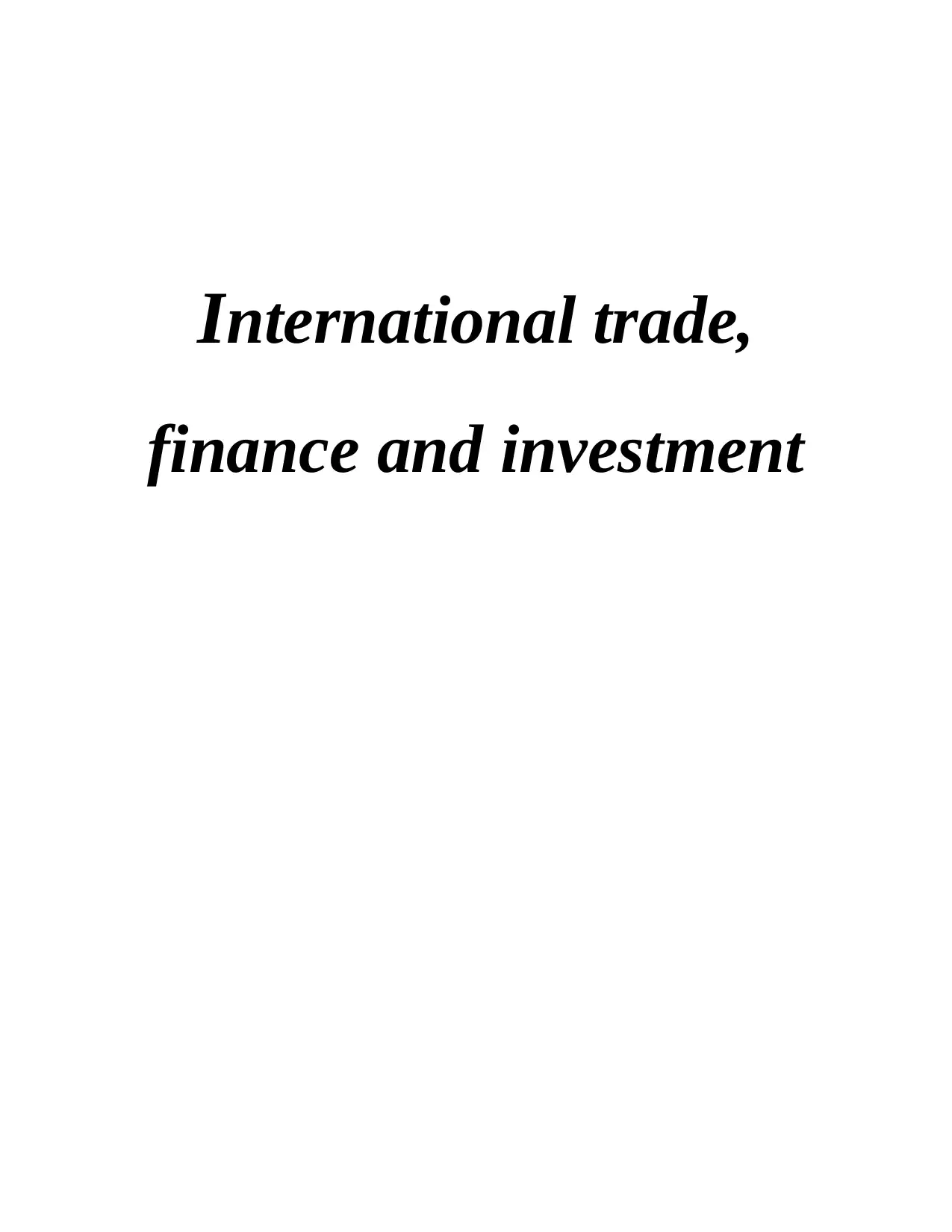
International trade,
finance and investment
finance and investment
Paraphrase This Document
Need a fresh take? Get an instant paraphrase of this document with our AI Paraphraser
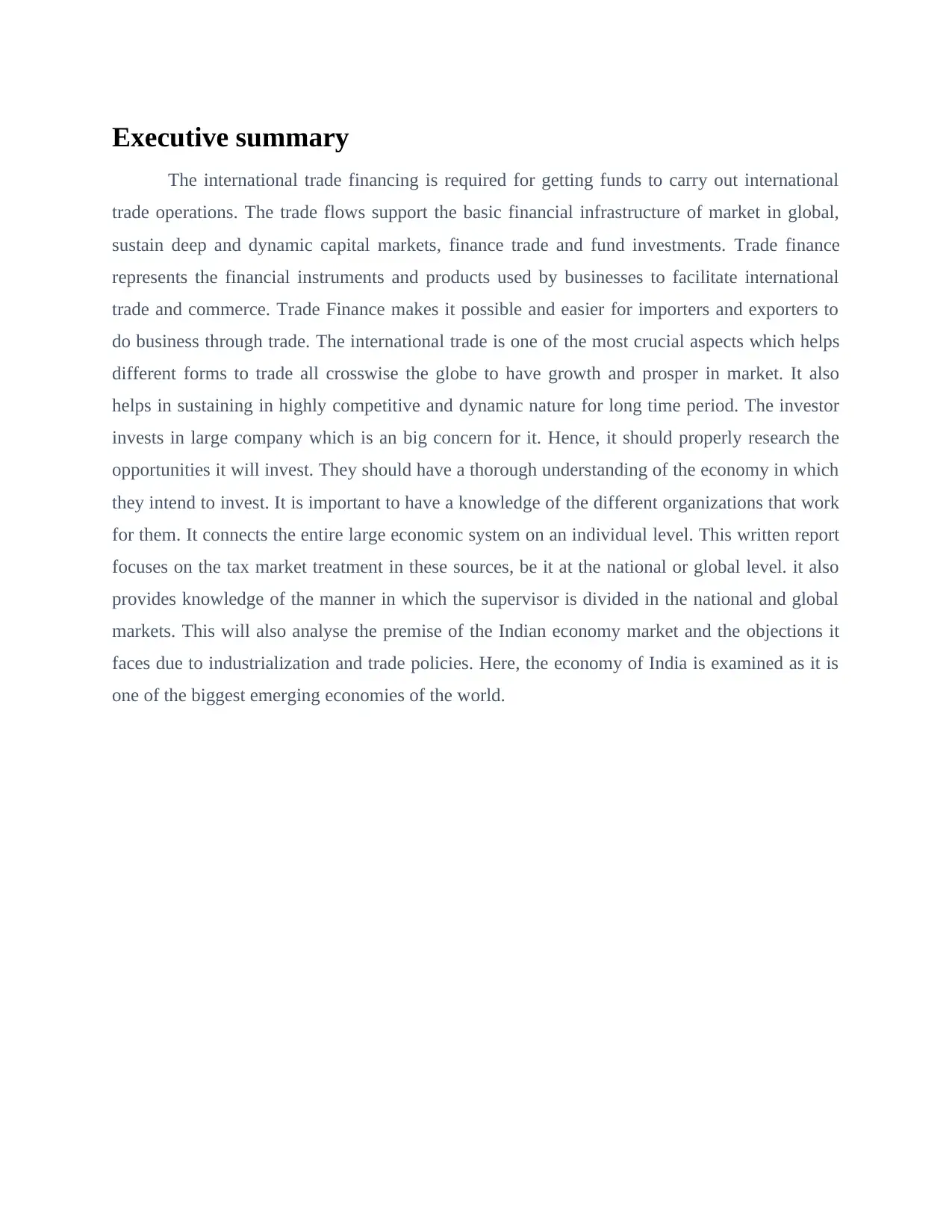
Executive summary
The international trade financing is required for getting funds to carry out international
trade operations. The trade flows support the basic financial infrastructure of market in global,
sustain deep and dynamic capital markets, finance trade and fund investments. Trade finance
represents the financial instruments and products used by businesses to facilitate international
trade and commerce. Trade Finance makes it possible and easier for importers and exporters to
do business through trade. The international trade is one of the most crucial aspects which helps
different forms to trade all crosswise the globe to have growth and prosper in market. It also
helps in sustaining in highly competitive and dynamic nature for long time period. The investor
invests in large company which is an big concern for it. Hence, it should properly research the
opportunities it will invest. They should have a thorough understanding of the economy in which
they intend to invest. It is important to have a knowledge of the different organizations that work
for them. It connects the entire large economic system on an individual level. This written report
focuses on the tax market treatment in these sources, be it at the national or global level. it also
provides knowledge of the manner in which the supervisor is divided in the national and global
markets. This will also analyse the premise of the Indian economy market and the objections it
faces due to industrialization and trade policies. Here, the economy of India is examined as it is
one of the biggest emerging economies of the world.
The international trade financing is required for getting funds to carry out international
trade operations. The trade flows support the basic financial infrastructure of market in global,
sustain deep and dynamic capital markets, finance trade and fund investments. Trade finance
represents the financial instruments and products used by businesses to facilitate international
trade and commerce. Trade Finance makes it possible and easier for importers and exporters to
do business through trade. The international trade is one of the most crucial aspects which helps
different forms to trade all crosswise the globe to have growth and prosper in market. It also
helps in sustaining in highly competitive and dynamic nature for long time period. The investor
invests in large company which is an big concern for it. Hence, it should properly research the
opportunities it will invest. They should have a thorough understanding of the economy in which
they intend to invest. It is important to have a knowledge of the different organizations that work
for them. It connects the entire large economic system on an individual level. This written report
focuses on the tax market treatment in these sources, be it at the national or global level. it also
provides knowledge of the manner in which the supervisor is divided in the national and global
markets. This will also analyse the premise of the Indian economy market and the objections it
faces due to industrialization and trade policies. Here, the economy of India is examined as it is
one of the biggest emerging economies of the world.
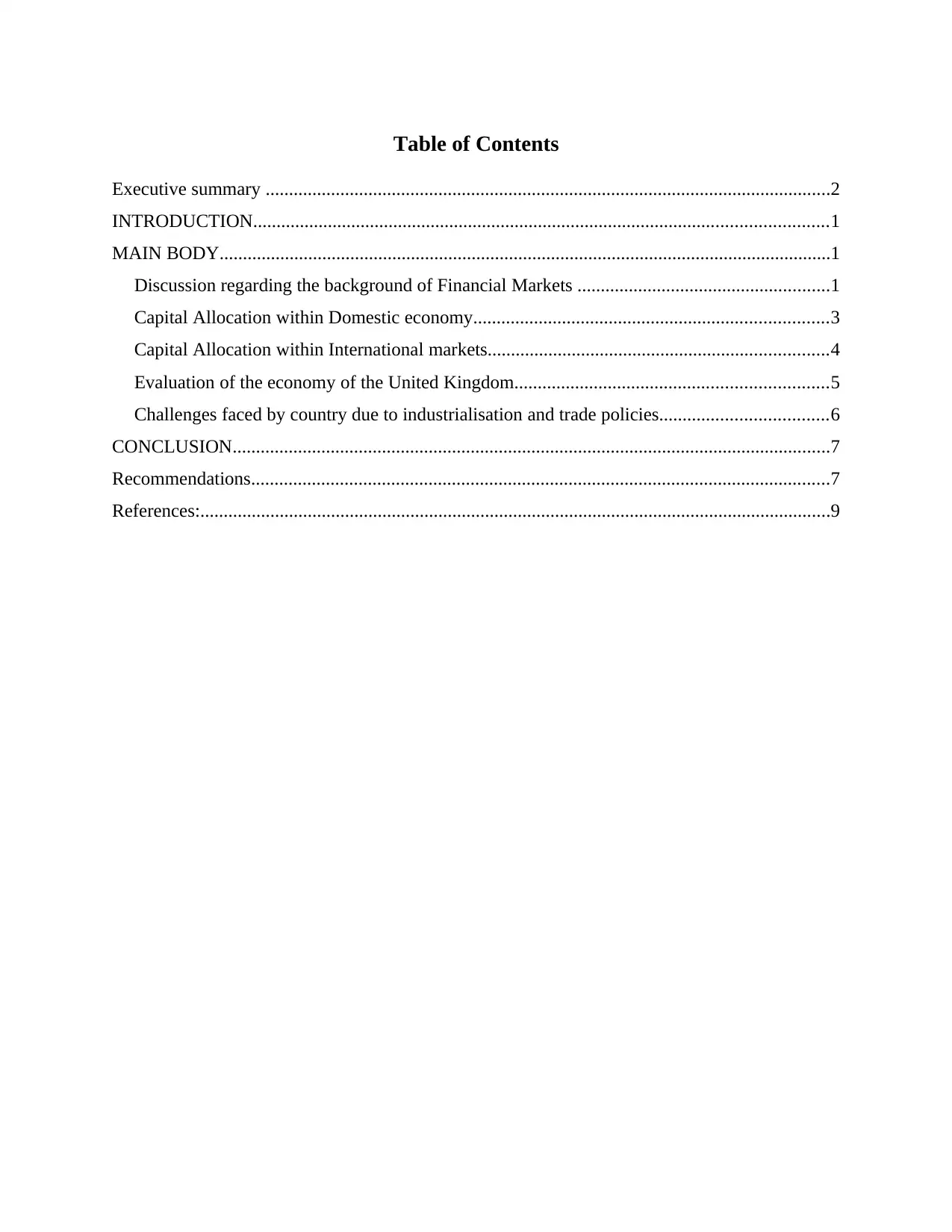
Table of Contents
Executive summary .........................................................................................................................2
INTRODUCTION...........................................................................................................................1
MAIN BODY...................................................................................................................................1
Discussion regarding the background of Financial Markets ......................................................1
Capital Allocation within Domestic economy............................................................................3
Capital Allocation within International markets.........................................................................4
Evaluation of the economy of the United Kingdom...................................................................5
Challenges faced by country due to industrialisation and trade policies....................................6
CONCLUSION................................................................................................................................7
Recommendations............................................................................................................................7
References:.......................................................................................................................................9
Executive summary .........................................................................................................................2
INTRODUCTION...........................................................................................................................1
MAIN BODY...................................................................................................................................1
Discussion regarding the background of Financial Markets ......................................................1
Capital Allocation within Domestic economy............................................................................3
Capital Allocation within International markets.........................................................................4
Evaluation of the economy of the United Kingdom...................................................................5
Challenges faced by country due to industrialisation and trade policies....................................6
CONCLUSION................................................................................................................................7
Recommendations............................................................................................................................7
References:.......................................................................................................................................9
⊘ This is a preview!⊘
Do you want full access?
Subscribe today to unlock all pages.

Trusted by 1+ million students worldwide
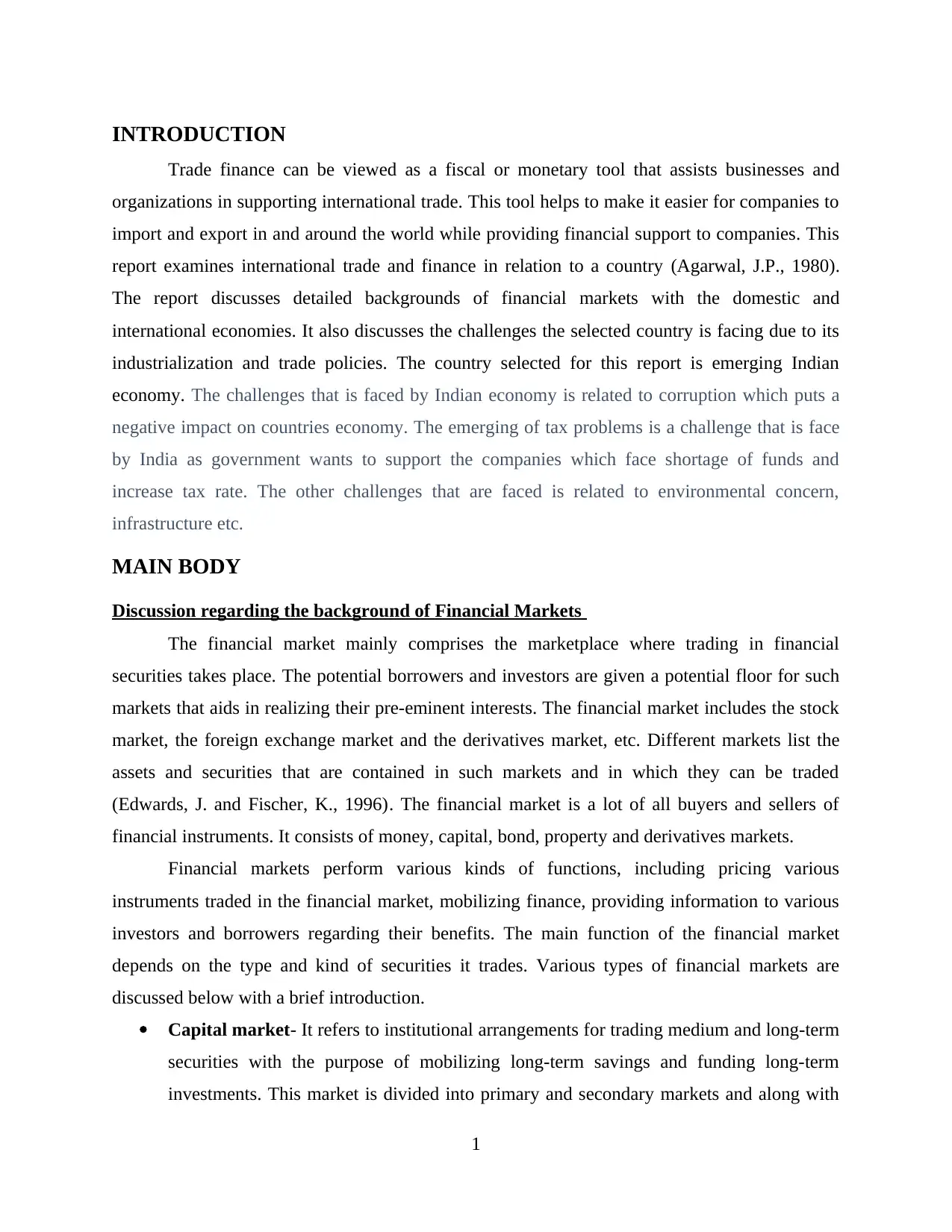
INTRODUCTION
Trade finance can be viewed as a fiscal or monetary tool that assists businesses and
organizations in supporting international trade. This tool helps to make it easier for companies to
import and export in and around the world while providing financial support to companies. This
report examines international trade and finance in relation to a country (Agarwal, J.P., 1980).
The report discusses detailed backgrounds of financial markets with the domestic and
international economies. It also discusses the challenges the selected country is facing due to its
industrialization and trade policies. The country selected for this report is emerging Indian
economy. The challenges that is faced by Indian economy is related to corruption which puts a
negative impact on countries economy. The emerging of tax problems is a challenge that is face
by India as government wants to support the companies which face shortage of funds and
increase tax rate. The other challenges that are faced is related to environmental concern,
infrastructure etc.
MAIN BODY
Discussion regarding the background of Financial Markets
The financial market mainly comprises the marketplace where trading in financial
securities takes place. The potential borrowers and investors are given a potential floor for such
markets that aids in realizing their pre-eminent interests. The financial market includes the stock
market, the foreign exchange market and the derivatives market, etc. Different markets list the
assets and securities that are contained in such markets and in which they can be traded
(Edwards, J. and Fischer, K., 1996). The financial market is a lot of all buyers and sellers of
financial instruments. It consists of money, capital, bond, property and derivatives markets.
Financial markets perform various kinds of functions, including pricing various
instruments traded in the financial market, mobilizing finance, providing information to various
investors and borrowers regarding their benefits. The main function of the financial market
depends on the type and kind of securities it trades. Various types of financial markets are
discussed below with a brief introduction.
Capital market- It refers to institutional arrangements for trading medium and long-term
securities with the purpose of mobilizing long-term savings and funding long-term
investments. This market is divided into primary and secondary markets and along with
1
Trade finance can be viewed as a fiscal or monetary tool that assists businesses and
organizations in supporting international trade. This tool helps to make it easier for companies to
import and export in and around the world while providing financial support to companies. This
report examines international trade and finance in relation to a country (Agarwal, J.P., 1980).
The report discusses detailed backgrounds of financial markets with the domestic and
international economies. It also discusses the challenges the selected country is facing due to its
industrialization and trade policies. The country selected for this report is emerging Indian
economy. The challenges that is faced by Indian economy is related to corruption which puts a
negative impact on countries economy. The emerging of tax problems is a challenge that is face
by India as government wants to support the companies which face shortage of funds and
increase tax rate. The other challenges that are faced is related to environmental concern,
infrastructure etc.
MAIN BODY
Discussion regarding the background of Financial Markets
The financial market mainly comprises the marketplace where trading in financial
securities takes place. The potential borrowers and investors are given a potential floor for such
markets that aids in realizing their pre-eminent interests. The financial market includes the stock
market, the foreign exchange market and the derivatives market, etc. Different markets list the
assets and securities that are contained in such markets and in which they can be traded
(Edwards, J. and Fischer, K., 1996). The financial market is a lot of all buyers and sellers of
financial instruments. It consists of money, capital, bond, property and derivatives markets.
Financial markets perform various kinds of functions, including pricing various
instruments traded in the financial market, mobilizing finance, providing information to various
investors and borrowers regarding their benefits. The main function of the financial market
depends on the type and kind of securities it trades. Various types of financial markets are
discussed below with a brief introduction.
Capital market- It refers to institutional arrangements for trading medium and long-term
securities with the purpose of mobilizing long-term savings and funding long-term
investments. This market is divided into primary and secondary markets and along with
1
Paraphrase This Document
Need a fresh take? Get an instant paraphrase of this document with our AI Paraphraser
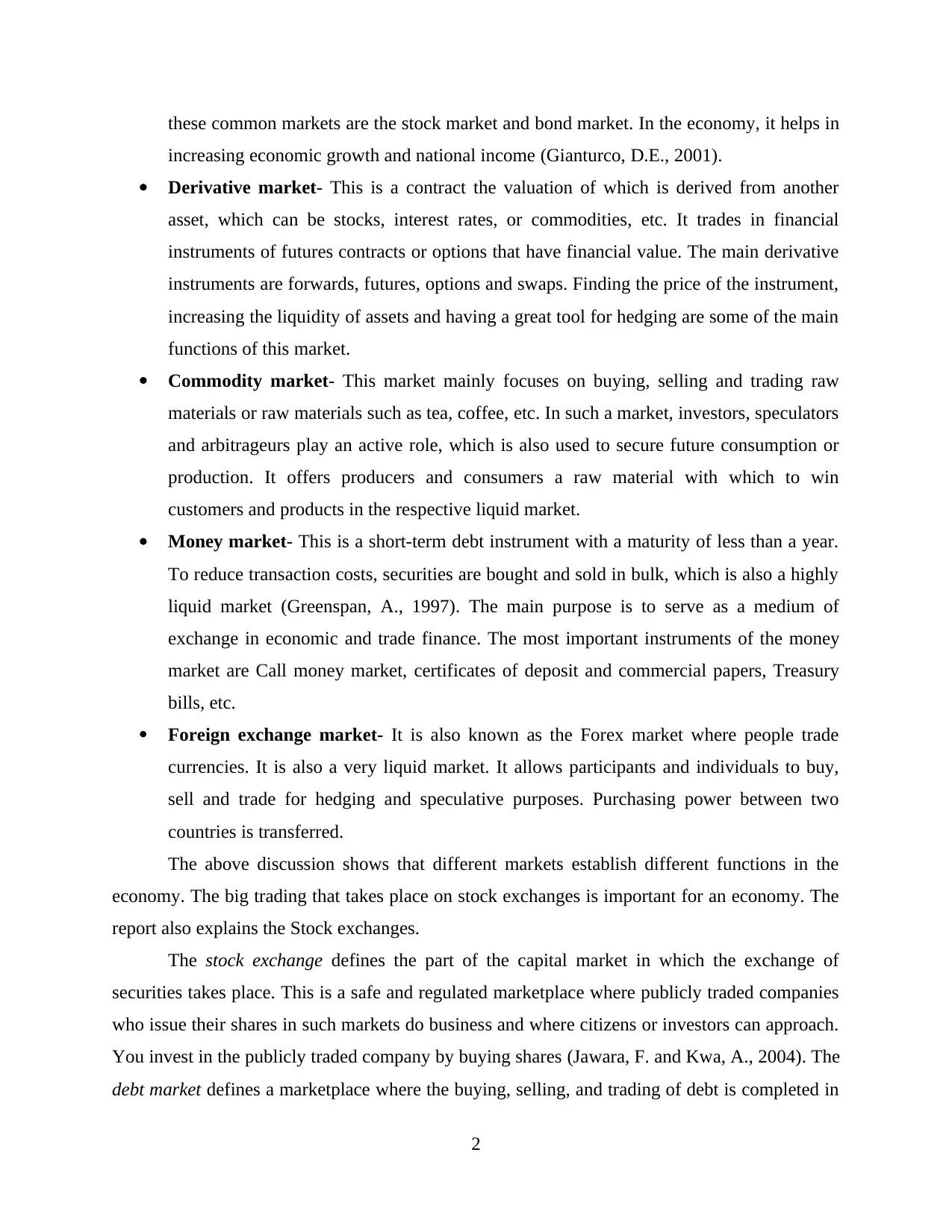
these common markets are the stock market and bond market. In the economy, it helps in
increasing economic growth and national income (Gianturco, D.E., 2001).
Derivative market- This is a contract the valuation of which is derived from another
asset, which can be stocks, interest rates, or commodities, etc. It trades in financial
instruments of futures contracts or options that have financial value. The main derivative
instruments are forwards, futures, options and swaps. Finding the price of the instrument,
increasing the liquidity of assets and having a great tool for hedging are some of the main
functions of this market.
Commodity market- This market mainly focuses on buying, selling and trading raw
materials or raw materials such as tea, coffee, etc. In such a market, investors, speculators
and arbitrageurs play an active role, which is also used to secure future consumption or
production. It offers producers and consumers a raw material with which to win
customers and products in the respective liquid market.
Money market- This is a short-term debt instrument with a maturity of less than a year.
To reduce transaction costs, securities are bought and sold in bulk, which is also a highly
liquid market (Greenspan, A., 1997). The main purpose is to serve as a medium of
exchange in economic and trade finance. The most important instruments of the money
market are Call money market, certificates of deposit and commercial papers, Treasury
bills, etc.
Foreign exchange market- It is also known as the Forex market where people trade
currencies. It is also a very liquid market. It allows participants and individuals to buy,
sell and trade for hedging and speculative purposes. Purchasing power between two
countries is transferred.
The above discussion shows that different markets establish different functions in the
economy. The big trading that takes place on stock exchanges is important for an economy. The
report also explains the Stock exchanges.
The stock exchange defines the part of the capital market in which the exchange of
securities takes place. This is a safe and regulated marketplace where publicly traded companies
who issue their shares in such markets do business and where citizens or investors can approach.
You invest in the publicly traded company by buying shares (Jawara, F. and Kwa, A., 2004). The
debt market defines a marketplace where the buying, selling, and trading of debt is completed in
2
increasing economic growth and national income (Gianturco, D.E., 2001).
Derivative market- This is a contract the valuation of which is derived from another
asset, which can be stocks, interest rates, or commodities, etc. It trades in financial
instruments of futures contracts or options that have financial value. The main derivative
instruments are forwards, futures, options and swaps. Finding the price of the instrument,
increasing the liquidity of assets and having a great tool for hedging are some of the main
functions of this market.
Commodity market- This market mainly focuses on buying, selling and trading raw
materials or raw materials such as tea, coffee, etc. In such a market, investors, speculators
and arbitrageurs play an active role, which is also used to secure future consumption or
production. It offers producers and consumers a raw material with which to win
customers and products in the respective liquid market.
Money market- This is a short-term debt instrument with a maturity of less than a year.
To reduce transaction costs, securities are bought and sold in bulk, which is also a highly
liquid market (Greenspan, A., 1997). The main purpose is to serve as a medium of
exchange in economic and trade finance. The most important instruments of the money
market are Call money market, certificates of deposit and commercial papers, Treasury
bills, etc.
Foreign exchange market- It is also known as the Forex market where people trade
currencies. It is also a very liquid market. It allows participants and individuals to buy,
sell and trade for hedging and speculative purposes. Purchasing power between two
countries is transferred.
The above discussion shows that different markets establish different functions in the
economy. The big trading that takes place on stock exchanges is important for an economy. The
report also explains the Stock exchanges.
The stock exchange defines the part of the capital market in which the exchange of
securities takes place. This is a safe and regulated marketplace where publicly traded companies
who issue their shares in such markets do business and where citizens or investors can approach.
You invest in the publicly traded company by buying shares (Jawara, F. and Kwa, A., 2004). The
debt market defines a marketplace where the buying, selling, and trading of debt is completed in
2
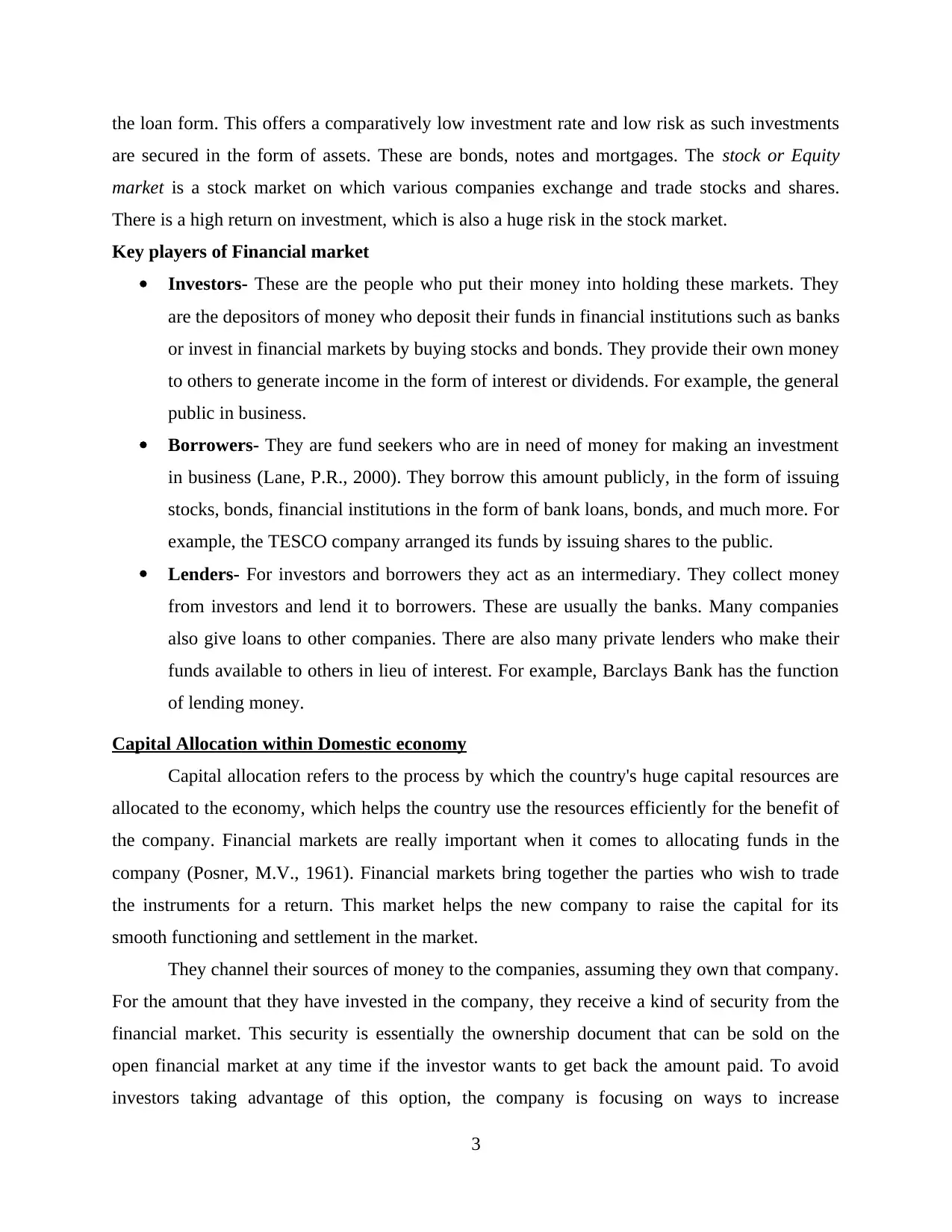
the loan form. This offers a comparatively low investment rate and low risk as such investments
are secured in the form of assets. These are bonds, notes and mortgages. The stock or Equity
market is a stock market on which various companies exchange and trade stocks and shares.
There is a high return on investment, which is also a huge risk in the stock market.
Key players of Financial market
Investors- These are the people who put their money into holding these markets. They
are the depositors of money who deposit their funds in financial institutions such as banks
or invest in financial markets by buying stocks and bonds. They provide their own money
to others to generate income in the form of interest or dividends. For example, the general
public in business.
Borrowers- They are fund seekers who are in need of money for making an investment
in business (Lane, P.R., 2000). They borrow this amount publicly, in the form of issuing
stocks, bonds, financial institutions in the form of bank loans, bonds, and much more. For
example, the TESCO company arranged its funds by issuing shares to the public.
Lenders- For investors and borrowers they act as an intermediary. They collect money
from investors and lend it to borrowers. These are usually the banks. Many companies
also give loans to other companies. There are also many private lenders who make their
funds available to others in lieu of interest. For example, Barclays Bank has the function
of lending money.
Capital Allocation within Domestic economy
Capital allocation refers to the process by which the country's huge capital resources are
allocated to the economy, which helps the country use the resources efficiently for the benefit of
the company. Financial markets are really important when it comes to allocating funds in the
company (Posner, M.V., 1961). Financial markets bring together the parties who wish to trade
the instruments for a return. This market helps the new company to raise the capital for its
smooth functioning and settlement in the market.
They channel their sources of money to the companies, assuming they own that company.
For the amount that they have invested in the company, they receive a kind of security from the
financial market. This security is essentially the ownership document that can be sold on the
open financial market at any time if the investor wants to get back the amount paid. To avoid
investors taking advantage of this option, the company is focusing on ways to increase
3
are secured in the form of assets. These are bonds, notes and mortgages. The stock or Equity
market is a stock market on which various companies exchange and trade stocks and shares.
There is a high return on investment, which is also a huge risk in the stock market.
Key players of Financial market
Investors- These are the people who put their money into holding these markets. They
are the depositors of money who deposit their funds in financial institutions such as banks
or invest in financial markets by buying stocks and bonds. They provide their own money
to others to generate income in the form of interest or dividends. For example, the general
public in business.
Borrowers- They are fund seekers who are in need of money for making an investment
in business (Lane, P.R., 2000). They borrow this amount publicly, in the form of issuing
stocks, bonds, financial institutions in the form of bank loans, bonds, and much more. For
example, the TESCO company arranged its funds by issuing shares to the public.
Lenders- For investors and borrowers they act as an intermediary. They collect money
from investors and lend it to borrowers. These are usually the banks. Many companies
also give loans to other companies. There are also many private lenders who make their
funds available to others in lieu of interest. For example, Barclays Bank has the function
of lending money.
Capital Allocation within Domestic economy
Capital allocation refers to the process by which the country's huge capital resources are
allocated to the economy, which helps the country use the resources efficiently for the benefit of
the company. Financial markets are really important when it comes to allocating funds in the
company (Posner, M.V., 1961). Financial markets bring together the parties who wish to trade
the instruments for a return. This market helps the new company to raise the capital for its
smooth functioning and settlement in the market.
They channel their sources of money to the companies, assuming they own that company.
For the amount that they have invested in the company, they receive a kind of security from the
financial market. This security is essentially the ownership document that can be sold on the
open financial market at any time if the investor wants to get back the amount paid. To avoid
investors taking advantage of this option, the company is focusing on ways to increase
3
⊘ This is a preview!⊘
Do you want full access?
Subscribe today to unlock all pages.

Trusted by 1+ million students worldwide
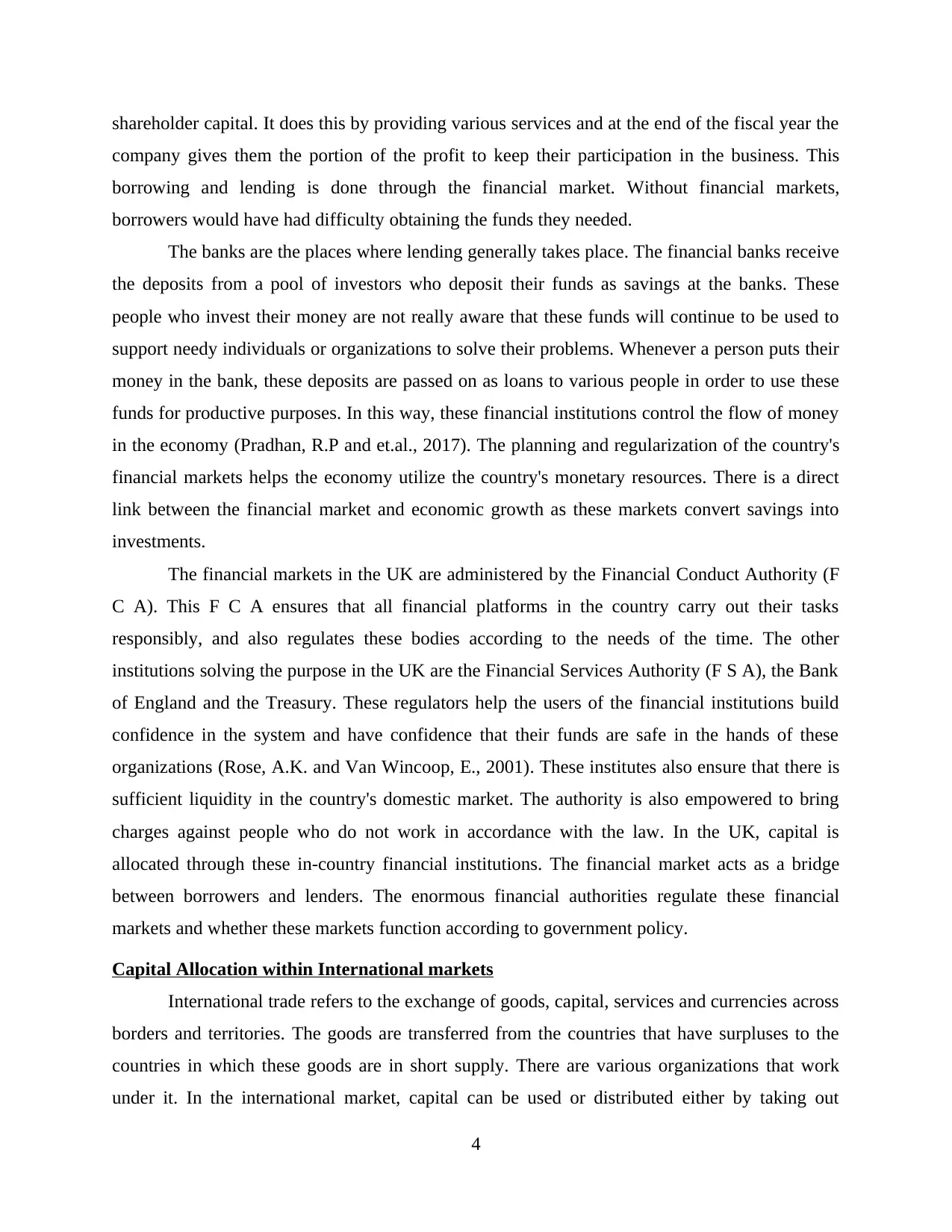
shareholder capital. It does this by providing various services and at the end of the fiscal year the
company gives them the portion of the profit to keep their participation in the business. This
borrowing and lending is done through the financial market. Without financial markets,
borrowers would have had difficulty obtaining the funds they needed.
The banks are the places where lending generally takes place. The financial banks receive
the deposits from a pool of investors who deposit their funds as savings at the banks. These
people who invest their money are not really aware that these funds will continue to be used to
support needy individuals or organizations to solve their problems. Whenever a person puts their
money in the bank, these deposits are passed on as loans to various people in order to use these
funds for productive purposes. In this way, these financial institutions control the flow of money
in the economy (Pradhan, R.P and et.al., 2017). The planning and regularization of the country's
financial markets helps the economy utilize the country's monetary resources. There is a direct
link between the financial market and economic growth as these markets convert savings into
investments.
The financial markets in the UK are administered by the Financial Conduct Authority (F
C A). This F C A ensures that all financial platforms in the country carry out their tasks
responsibly, and also regulates these bodies according to the needs of the time. The other
institutions solving the purpose in the UK are the Financial Services Authority (F S A), the Bank
of England and the Treasury. These regulators help the users of the financial institutions build
confidence in the system and have confidence that their funds are safe in the hands of these
organizations (Rose, A.K. and Van Wincoop, E., 2001). These institutes also ensure that there is
sufficient liquidity in the country's domestic market. The authority is also empowered to bring
charges against people who do not work in accordance with the law. In the UK, capital is
allocated through these in-country financial institutions. The financial market acts as a bridge
between borrowers and lenders. The enormous financial authorities regulate these financial
markets and whether these markets function according to government policy.
Capital Allocation within International markets
International trade refers to the exchange of goods, capital, services and currencies across
borders and territories. The goods are transferred from the countries that have surpluses to the
countries in which these goods are in short supply. There are various organizations that work
under it. In the international market, capital can be used or distributed either by taking out
4
company gives them the portion of the profit to keep their participation in the business. This
borrowing and lending is done through the financial market. Without financial markets,
borrowers would have had difficulty obtaining the funds they needed.
The banks are the places where lending generally takes place. The financial banks receive
the deposits from a pool of investors who deposit their funds as savings at the banks. These
people who invest their money are not really aware that these funds will continue to be used to
support needy individuals or organizations to solve their problems. Whenever a person puts their
money in the bank, these deposits are passed on as loans to various people in order to use these
funds for productive purposes. In this way, these financial institutions control the flow of money
in the economy (Pradhan, R.P and et.al., 2017). The planning and regularization of the country's
financial markets helps the economy utilize the country's monetary resources. There is a direct
link between the financial market and economic growth as these markets convert savings into
investments.
The financial markets in the UK are administered by the Financial Conduct Authority (F
C A). This F C A ensures that all financial platforms in the country carry out their tasks
responsibly, and also regulates these bodies according to the needs of the time. The other
institutions solving the purpose in the UK are the Financial Services Authority (F S A), the Bank
of England and the Treasury. These regulators help the users of the financial institutions build
confidence in the system and have confidence that their funds are safe in the hands of these
organizations (Rose, A.K. and Van Wincoop, E., 2001). These institutes also ensure that there is
sufficient liquidity in the country's domestic market. The authority is also empowered to bring
charges against people who do not work in accordance with the law. In the UK, capital is
allocated through these in-country financial institutions. The financial market acts as a bridge
between borrowers and lenders. The enormous financial authorities regulate these financial
markets and whether these markets function according to government policy.
Capital Allocation within International markets
International trade refers to the exchange of goods, capital, services and currencies across
borders and territories. The goods are transferred from the countries that have surpluses to the
countries in which these goods are in short supply. There are various organizations that work
under it. In the international market, capital can be used or distributed either by taking out
4
Paraphrase This Document
Need a fresh take? Get an instant paraphrase of this document with our AI Paraphraser
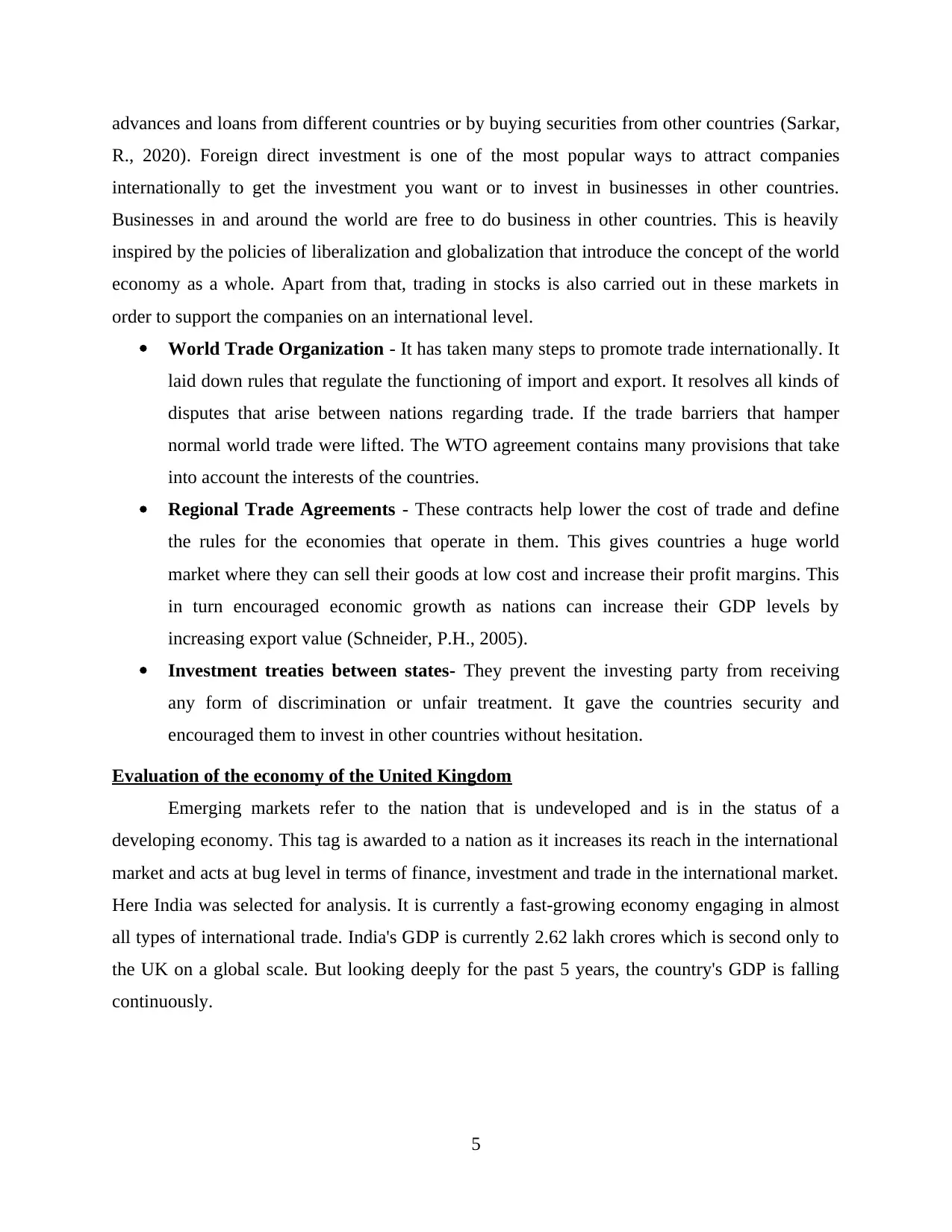
advances and loans from different countries or by buying securities from other countries (Sarkar,
R., 2020). Foreign direct investment is one of the most popular ways to attract companies
internationally to get the investment you want or to invest in businesses in other countries.
Businesses in and around the world are free to do business in other countries. This is heavily
inspired by the policies of liberalization and globalization that introduce the concept of the world
economy as a whole. Apart from that, trading in stocks is also carried out in these markets in
order to support the companies on an international level.
World Trade Organization - It has taken many steps to promote trade internationally. It
laid down rules that regulate the functioning of import and export. It resolves all kinds of
disputes that arise between nations regarding trade. If the trade barriers that hamper
normal world trade were lifted. The WTO agreement contains many provisions that take
into account the interests of the countries.
Regional Trade Agreements - These contracts help lower the cost of trade and define
the rules for the economies that operate in them. This gives countries a huge world
market where they can sell their goods at low cost and increase their profit margins. This
in turn encouraged economic growth as nations can increase their GDP levels by
increasing export value (Schneider, P.H., 2005).
Investment treaties between states- They prevent the investing party from receiving
any form of discrimination or unfair treatment. It gave the countries security and
encouraged them to invest in other countries without hesitation.
Evaluation of the economy of the United Kingdom
Emerging markets refer to the nation that is undeveloped and is in the status of a
developing economy. This tag is awarded to a nation as it increases its reach in the international
market and acts at bug level in terms of finance, investment and trade in the international market.
Here India was selected for analysis. It is currently a fast-growing economy engaging in almost
all types of international trade. India's GDP is currently 2.62 lakh crores which is second only to
the UK on a global scale. But looking deeply for the past 5 years, the country's GDP is falling
continuously.
5
R., 2020). Foreign direct investment is one of the most popular ways to attract companies
internationally to get the investment you want or to invest in businesses in other countries.
Businesses in and around the world are free to do business in other countries. This is heavily
inspired by the policies of liberalization and globalization that introduce the concept of the world
economy as a whole. Apart from that, trading in stocks is also carried out in these markets in
order to support the companies on an international level.
World Trade Organization - It has taken many steps to promote trade internationally. It
laid down rules that regulate the functioning of import and export. It resolves all kinds of
disputes that arise between nations regarding trade. If the trade barriers that hamper
normal world trade were lifted. The WTO agreement contains many provisions that take
into account the interests of the countries.
Regional Trade Agreements - These contracts help lower the cost of trade and define
the rules for the economies that operate in them. This gives countries a huge world
market where they can sell their goods at low cost and increase their profit margins. This
in turn encouraged economic growth as nations can increase their GDP levels by
increasing export value (Schneider, P.H., 2005).
Investment treaties between states- They prevent the investing party from receiving
any form of discrimination or unfair treatment. It gave the countries security and
encouraged them to invest in other countries without hesitation.
Evaluation of the economy of the United Kingdom
Emerging markets refer to the nation that is undeveloped and is in the status of a
developing economy. This tag is awarded to a nation as it increases its reach in the international
market and acts at bug level in terms of finance, investment and trade in the international market.
Here India was selected for analysis. It is currently a fast-growing economy engaging in almost
all types of international trade. India's GDP is currently 2.62 lakh crores which is second only to
the UK on a global scale. But looking deeply for the past 5 years, the country's GDP is falling
continuously.
5
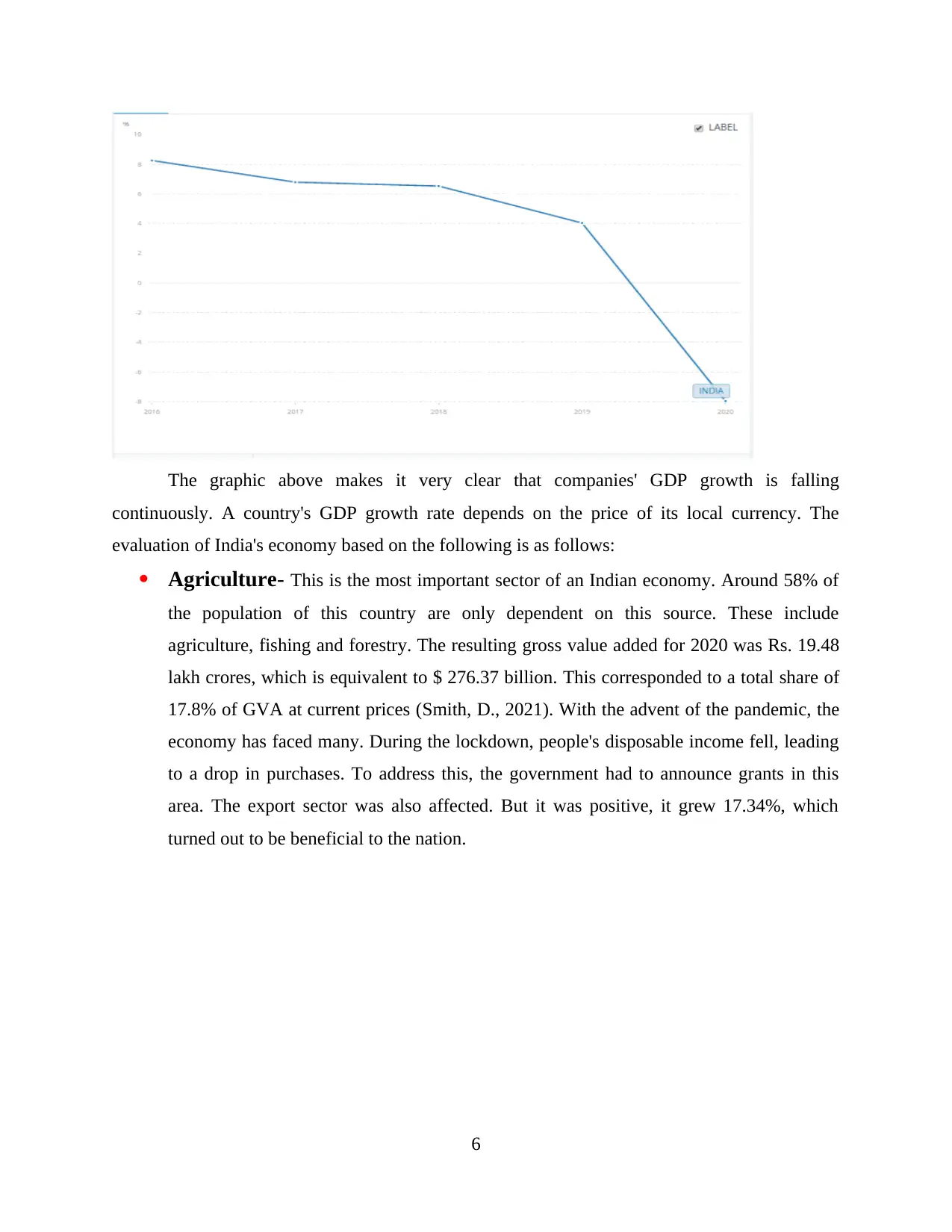
The graphic above makes it very clear that companies' GDP growth is falling
continuously. A country's GDP growth rate depends on the price of its local currency. The
evaluation of India's economy based on the following is as follows:
Agriculture- This is the most important sector of an Indian economy. Around 58% of
the population of this country are only dependent on this source. These include
agriculture, fishing and forestry. The resulting gross value added for 2020 was Rs. 19.48
lakh crores, which is equivalent to $ 276.37 billion. This corresponded to a total share of
17.8% of GVA at current prices (Smith, D., 2021). With the advent of the pandemic, the
economy has faced many. During the lockdown, people's disposable income fell, leading
to a drop in purchases. To address this, the government had to announce grants in this
area. The export sector was also affected. But it was positive, it grew 17.34%, which
turned out to be beneficial to the nation.
6
continuously. A country's GDP growth rate depends on the price of its local currency. The
evaluation of India's economy based on the following is as follows:
Agriculture- This is the most important sector of an Indian economy. Around 58% of
the population of this country are only dependent on this source. These include
agriculture, fishing and forestry. The resulting gross value added for 2020 was Rs. 19.48
lakh crores, which is equivalent to $ 276.37 billion. This corresponded to a total share of
17.8% of GVA at current prices (Smith, D., 2021). With the advent of the pandemic, the
economy has faced many. During the lockdown, people's disposable income fell, leading
to a drop in purchases. To address this, the government had to announce grants in this
area. The export sector was also affected. But it was positive, it grew 17.34%, which
turned out to be beneficial to the nation.
6
⊘ This is a preview!⊘
Do you want full access?
Subscribe today to unlock all pages.

Trusted by 1+ million students worldwide
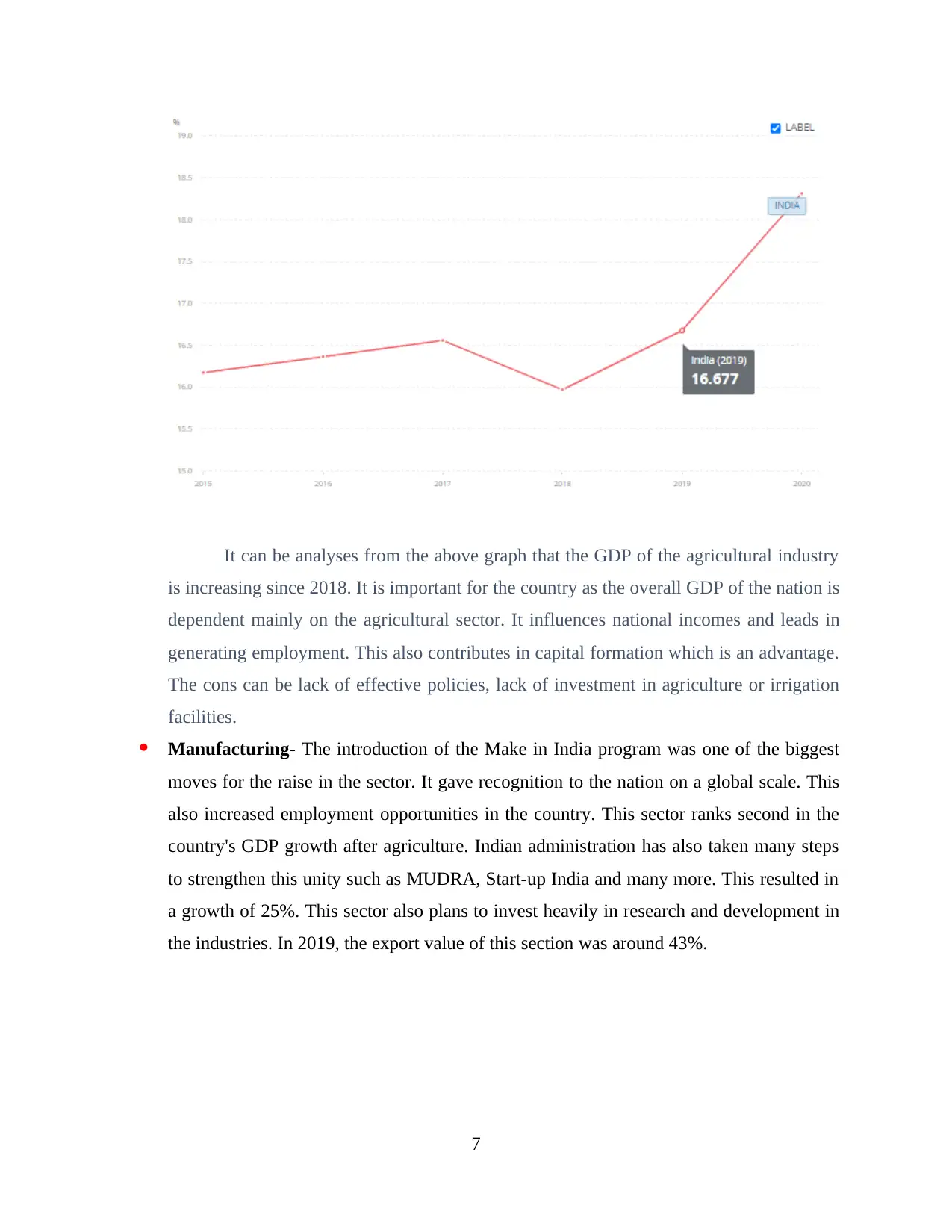
It can be analyses from the above graph that the GDP of the agricultural industry
is increasing since 2018. It is important for the country as the overall GDP of the nation is
dependent mainly on the agricultural sector. It influences national incomes and leads in
generating employment. This also contributes in capital formation which is an advantage.
The cons can be lack of effective policies, lack of investment in agriculture or irrigation
facilities.
Manufacturing- The introduction of the Make in India program was one of the biggest
moves for the raise in the sector. It gave recognition to the nation on a global scale. This
also increased employment opportunities in the country. This sector ranks second in the
country's GDP growth after agriculture. Indian administration has also taken many steps
to strengthen this unity such as MUDRA, Start-up India and many more. This resulted in
a growth of 25%. This sector also plans to invest heavily in research and development in
the industries. In 2019, the export value of this section was around 43%.
7
is increasing since 2018. It is important for the country as the overall GDP of the nation is
dependent mainly on the agricultural sector. It influences national incomes and leads in
generating employment. This also contributes in capital formation which is an advantage.
The cons can be lack of effective policies, lack of investment in agriculture or irrigation
facilities.
Manufacturing- The introduction of the Make in India program was one of the biggest
moves for the raise in the sector. It gave recognition to the nation on a global scale. This
also increased employment opportunities in the country. This sector ranks second in the
country's GDP growth after agriculture. Indian administration has also taken many steps
to strengthen this unity such as MUDRA, Start-up India and many more. This resulted in
a growth of 25%. This sector also plans to invest heavily in research and development in
the industries. In 2019, the export value of this section was around 43%.
7
Paraphrase This Document
Need a fresh take? Get an instant paraphrase of this document with our AI Paraphraser
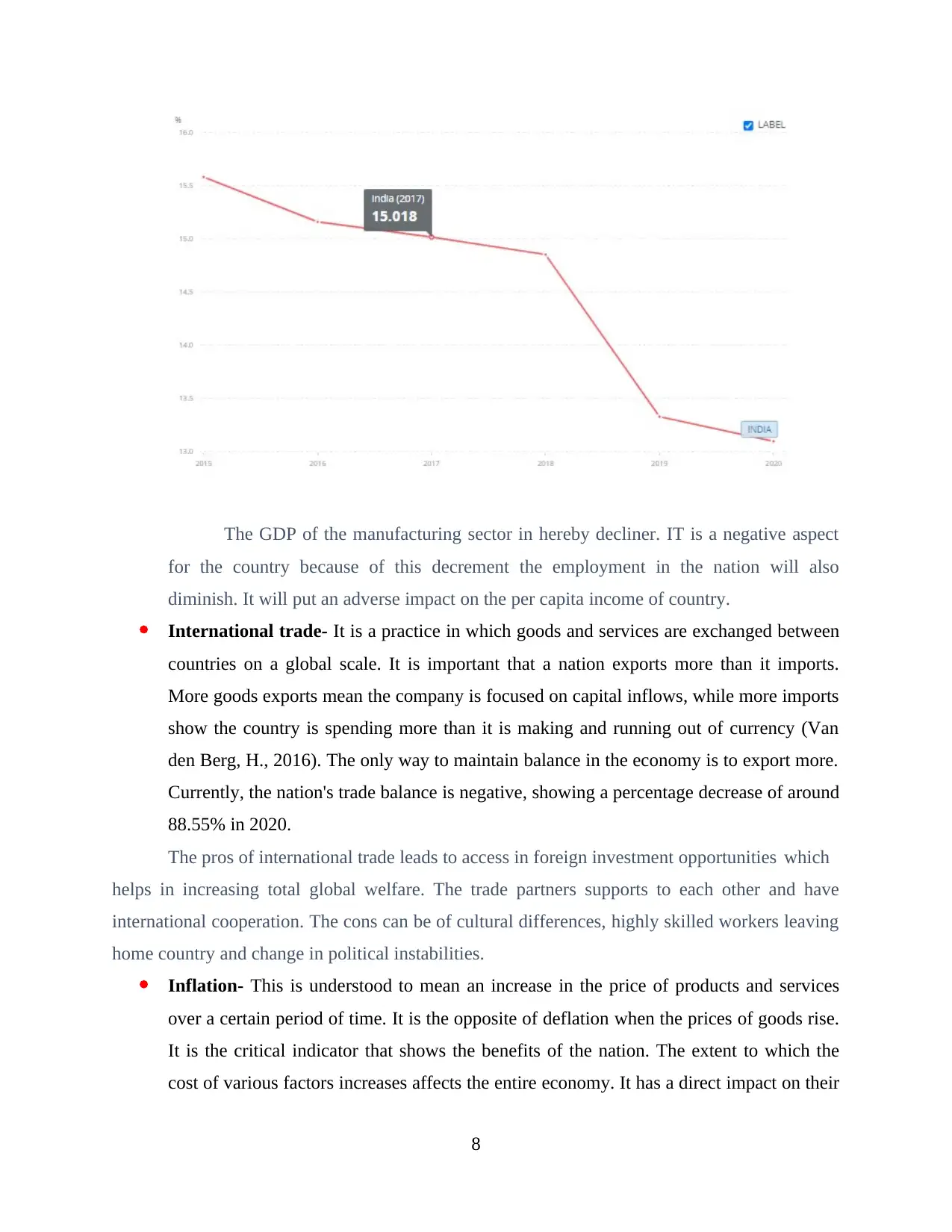
The GDP of the manufacturing sector in hereby decliner. IT is a negative aspect
for the country because of this decrement the employment in the nation will also
diminish. It will put an adverse impact on the per capita income of country.
International trade- It is a practice in which goods and services are exchanged between
countries on a global scale. It is important that a nation exports more than it imports.
More goods exports mean the company is focused on capital inflows, while more imports
show the country is spending more than it is making and running out of currency (Van
den Berg, H., 2016). The only way to maintain balance in the economy is to export more.
Currently, the nation's trade balance is negative, showing a percentage decrease of around
88.55% in 2020.
The pros of international trade leads to access in foreign investment opportunities which
helps in increasing total global welfare. The trade partners supports to each other and have
international cooperation. The cons can be of cultural differences, highly skilled workers leaving
home country and change in political instabilities.
Inflation- This is understood to mean an increase in the price of products and services
over a certain period of time. It is the opposite of deflation when the prices of goods rise.
It is the critical indicator that shows the benefits of the nation. The extent to which the
cost of various factors increases affects the entire economy. It has a direct impact on their
8
for the country because of this decrement the employment in the nation will also
diminish. It will put an adverse impact on the per capita income of country.
International trade- It is a practice in which goods and services are exchanged between
countries on a global scale. It is important that a nation exports more than it imports.
More goods exports mean the company is focused on capital inflows, while more imports
show the country is spending more than it is making and running out of currency (Van
den Berg, H., 2016). The only way to maintain balance in the economy is to export more.
Currently, the nation's trade balance is negative, showing a percentage decrease of around
88.55% in 2020.
The pros of international trade leads to access in foreign investment opportunities which
helps in increasing total global welfare. The trade partners supports to each other and have
international cooperation. The cons can be of cultural differences, highly skilled workers leaving
home country and change in political instabilities.
Inflation- This is understood to mean an increase in the price of products and services
over a certain period of time. It is the opposite of deflation when the prices of goods rise.
It is the critical indicator that shows the benefits of the nation. The extent to which the
cost of various factors increases affects the entire economy. It has a direct impact on their
8
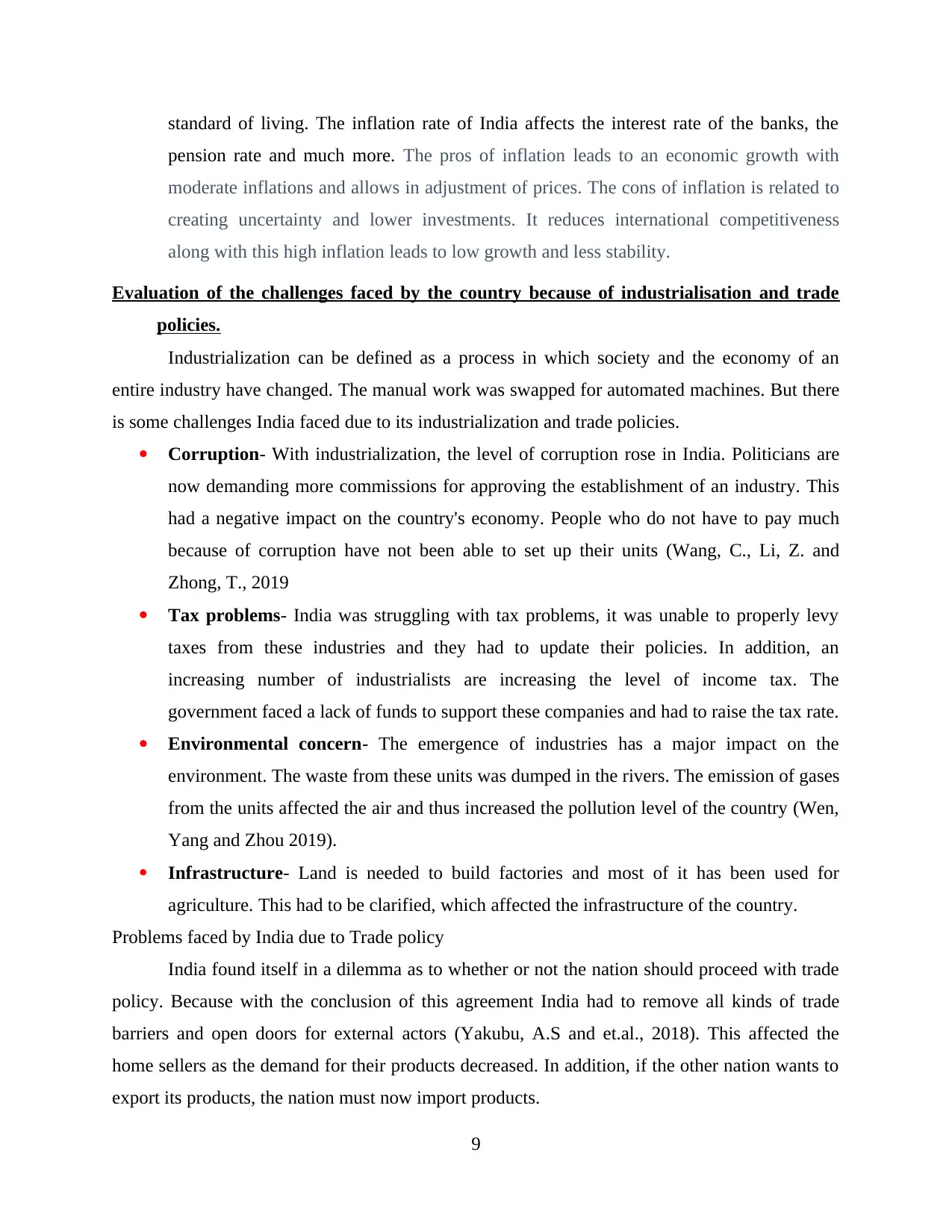
standard of living. The inflation rate of India affects the interest rate of the banks, the
pension rate and much more. The pros of inflation leads to an economic growth with
moderate inflations and allows in adjustment of prices. The cons of inflation is related to
creating uncertainty and lower investments. It reduces international competitiveness
along with this high inflation leads to low growth and less stability.
Evaluation of the challenges faced by the country because of industrialisation and trade
policies.
Industrialization can be defined as a process in which society and the economy of an
entire industry have changed. The manual work was swapped for automated machines. But there
is some challenges India faced due to its industrialization and trade policies.
Corruption- With industrialization, the level of corruption rose in India. Politicians are
now demanding more commissions for approving the establishment of an industry. This
had a negative impact on the country's economy. People who do not have to pay much
because of corruption have not been able to set up their units (Wang, C., Li, Z. and
Zhong, T., 2019
Tax problems- India was struggling with tax problems, it was unable to properly levy
taxes from these industries and they had to update their policies. In addition, an
increasing number of industrialists are increasing the level of income tax. The
government faced a lack of funds to support these companies and had to raise the tax rate.
Environmental concern- The emergence of industries has a major impact on the
environment. The waste from these units was dumped in the rivers. The emission of gases
from the units affected the air and thus increased the pollution level of the country (Wen,
Yang and Zhou 2019).
Infrastructure- Land is needed to build factories and most of it has been used for
agriculture. This had to be clarified, which affected the infrastructure of the country.
Problems faced by India due to Trade policy
India found itself in a dilemma as to whether or not the nation should proceed with trade
policy. Because with the conclusion of this agreement India had to remove all kinds of trade
barriers and open doors for external actors (Yakubu, A.S and et.al., 2018). This affected the
home sellers as the demand for their products decreased. In addition, if the other nation wants to
export its products, the nation must now import products.
9
pension rate and much more. The pros of inflation leads to an economic growth with
moderate inflations and allows in adjustment of prices. The cons of inflation is related to
creating uncertainty and lower investments. It reduces international competitiveness
along with this high inflation leads to low growth and less stability.
Evaluation of the challenges faced by the country because of industrialisation and trade
policies.
Industrialization can be defined as a process in which society and the economy of an
entire industry have changed. The manual work was swapped for automated machines. But there
is some challenges India faced due to its industrialization and trade policies.
Corruption- With industrialization, the level of corruption rose in India. Politicians are
now demanding more commissions for approving the establishment of an industry. This
had a negative impact on the country's economy. People who do not have to pay much
because of corruption have not been able to set up their units (Wang, C., Li, Z. and
Zhong, T., 2019
Tax problems- India was struggling with tax problems, it was unable to properly levy
taxes from these industries and they had to update their policies. In addition, an
increasing number of industrialists are increasing the level of income tax. The
government faced a lack of funds to support these companies and had to raise the tax rate.
Environmental concern- The emergence of industries has a major impact on the
environment. The waste from these units was dumped in the rivers. The emission of gases
from the units affected the air and thus increased the pollution level of the country (Wen,
Yang and Zhou 2019).
Infrastructure- Land is needed to build factories and most of it has been used for
agriculture. This had to be clarified, which affected the infrastructure of the country.
Problems faced by India due to Trade policy
India found itself in a dilemma as to whether or not the nation should proceed with trade
policy. Because with the conclusion of this agreement India had to remove all kinds of trade
barriers and open doors for external actors (Yakubu, A.S and et.al., 2018). This affected the
home sellers as the demand for their products decreased. In addition, if the other nation wants to
export its products, the nation must now import products.
9
⊘ This is a preview!⊘
Do you want full access?
Subscribe today to unlock all pages.

Trusted by 1+ million students worldwide
1 out of 15
Related Documents
Your All-in-One AI-Powered Toolkit for Academic Success.
+13062052269
info@desklib.com
Available 24*7 on WhatsApp / Email
![[object Object]](/_next/static/media/star-bottom.7253800d.svg)
Unlock your academic potential
Copyright © 2020–2025 A2Z Services. All Rights Reserved. Developed and managed by ZUCOL.


